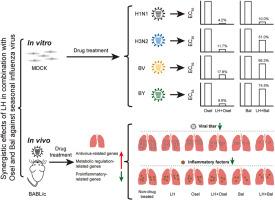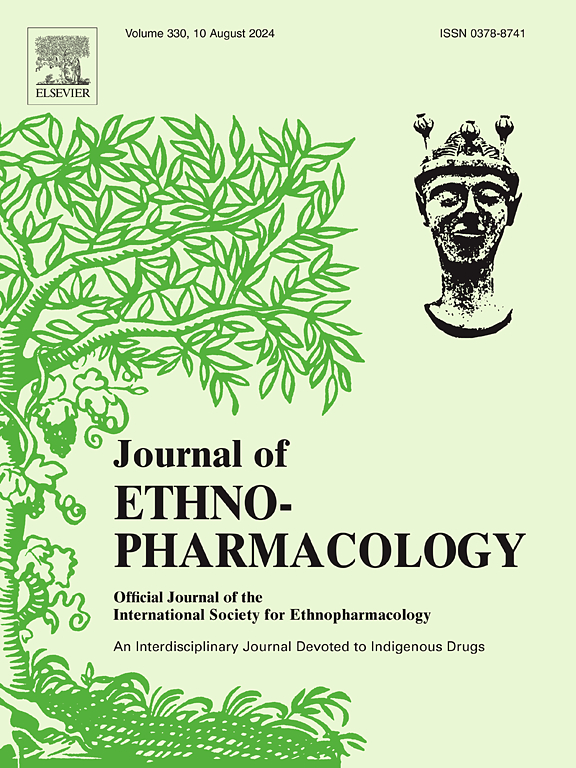Synergistic effects of Lianhuaqingwen in combination with Oseltamivir and Baloxavir against seasonal influenza virus: In vitro and in vivo assessment
IF 4.8
2区 医学
Q1 CHEMISTRY, MEDICINAL
引用次数: 0
Abstract
Ethnopharmacological relevance
Lianhuaqingwen (LH), a traditional Chinese medicine, presents a broad-spectrum antiviral effect and has been widely used to treat influenza. Given the potential rise of drug-resistant influenza viruses, it is necessary to develop new antiviral drugs and explore combination therapies involving LH in tandem with existing antivirals such as Oseltamivir acid (Osel) or Baloxavir (Bal). These multidrug combinations could help effectively control the seasonal influenza epidemics and reduce the disease burden.
Aim of the study
This study aimed to evaluate the antiviral effects of LH, alone and in combination with Osel or Bal, against human seasonal influenza viruses in vitro and in vivo models.
Materials and methods
The antiviral efficacy of LH alone and LH in combination with Osel/Bal against seasonal influenza A viruses (IAVs) (H1N1 and H3N2 subtypes) and influenza B viruses (IBVs) (BV- and BY-lineages) was assessed in vitro using MDCK cells. The median effective concentration (EC50) was determined, and the drug synergies were analyzed. Additionally, the antiviral activity of LH monotherapy and LH + Osel/Bal combination therapy were evaluated in vivo using an H1N1-infected BABL/c mouse model by monitoring changes in body weight, survival rate, lung viral titer, pathological damage, and inflammatory reaction.
Results
In vitro, LH alone and in combination with Osel/Bal exhibited antiviral activity against both IAVs and IBVs. The addition of LH to Osel/Bal improved the therapeutic efficacy compared to Osel/Bal alone. In vivo, LH monotherapy reduced body weight loss and increased the survival rates of H1N1-infected mice. LH in combination with Osel/Bal resulted in lower virus titers, more effective relief of pathological damage, and comparable low expression of inflammatory factors in the lungs of H1N1-infected mice compared to the use of Osel/Bal alone. Transcriptomic analysis of the lungs revealed that LH + Osel/Bal significantly increased the expression of genes associated with antiviral and anti-inflammatory effects.
Conclusions
This study evaluated the antiviral effects of LH monotherapy and combination therapy with Osel/Bal against human seasonal influenza viruses in vitro and in vivo models. The results suggest that combining LH with Osel or Bal could enhance the antiviral efficiency for influenza viruses compared to the monotherapy using any of these three drugs.

联华青蒿素与奥司他韦和巴洛沙韦联用抗季节性流感病毒的协同作用:体外和体内评估。
民族药理学意义:传统中药莲花清心丸(LH)具有广谱抗病毒作用,被广泛用于治疗流感。鉴于抗药性流感病毒的潜在增加,有必要开发新的抗病毒药物,并探索 LH 与现有抗病毒药物(如奥司他韦酸(Osel)或巴洛沙韦(Bal))的联合疗法。这些多药联合疗法有助于有效控制季节性流感疫情,减轻疾病负担:本研究旨在评估 LH 单独或与 Osel 或 Bal 联合使用在体外和体内模型中对人类季节性流感病毒的抗病毒效果:使用 MDCK 细胞在体外评估了 LH 单独和 LH 与 Osel/Bal 联用对季节性甲型流感病毒(IAVs)(H1N1 和 H3N2 亚型)和乙型流感病毒(IBVs)(BV- 和 BY-系)的抗病毒效果。确定了中位有效浓度(EC50),并分析了药物的协同作用。此外,还使用 H1N1 感染的 BABL/c 小鼠模型,通过监测体重、存活率、肺部病毒滴度、病理损伤和炎症反应的变化,评估了 LH 单药疗法和 LH + Osel/Bal 联合疗法的体内抗病毒活性:结果:在体外,LH单独或与Osel/Bal联合使用均可对IAV和IBV产生抗病毒活性。与单独使用 Osel/Bal 相比,在 Osel/Bal 中添加 LH 可提高疗效。在体内,LH 单药治疗可减少 H1N1 感染小鼠的体重减轻,并提高其存活率。与单独使用奥赛/巴尔相比,LH与奥赛/巴尔联合使用可使H1N1感染小鼠肺部的病毒滴度更低,病理损伤得到更有效的缓解,炎症因子的表达也相当低。肺部转录组分析表明,LH+奥赛尔/巴尔可显著增加与抗病毒和抗炎作用相关的基因的表达:本研究在体外和体内模型中评估了 LH 单药治疗和与 Osel/Bal 联合治疗对人类季节性流感病毒的抗病毒效果。结果表明,与单药治疗相比,LH与奥赛尔或巴尔联合治疗可提高对流感病毒的抗病毒效率。
本文章由计算机程序翻译,如有差异,请以英文原文为准。
求助全文
约1分钟内获得全文
求助全文
来源期刊

Journal of ethnopharmacology
医学-全科医学与补充医学
CiteScore
10.30
自引率
5.60%
发文量
967
审稿时长
77 days
期刊介绍:
The Journal of Ethnopharmacology is dedicated to the exchange of information and understandings about people''s use of plants, fungi, animals, microorganisms and minerals and their biological and pharmacological effects based on the principles established through international conventions. Early people confronted with illness and disease, discovered a wealth of useful therapeutic agents in the plant and animal kingdoms. The empirical knowledge of these medicinal substances and their toxic potential was passed on by oral tradition and sometimes recorded in herbals and other texts on materia medica. Many valuable drugs of today (e.g., atropine, ephedrine, tubocurarine, digoxin, reserpine) came into use through the study of indigenous remedies. Chemists continue to use plant-derived drugs (e.g., morphine, taxol, physostigmine, quinidine, emetine) as prototypes in their attempts to develop more effective and less toxic medicinals.
 求助内容:
求助内容: 应助结果提醒方式:
应助结果提醒方式:


